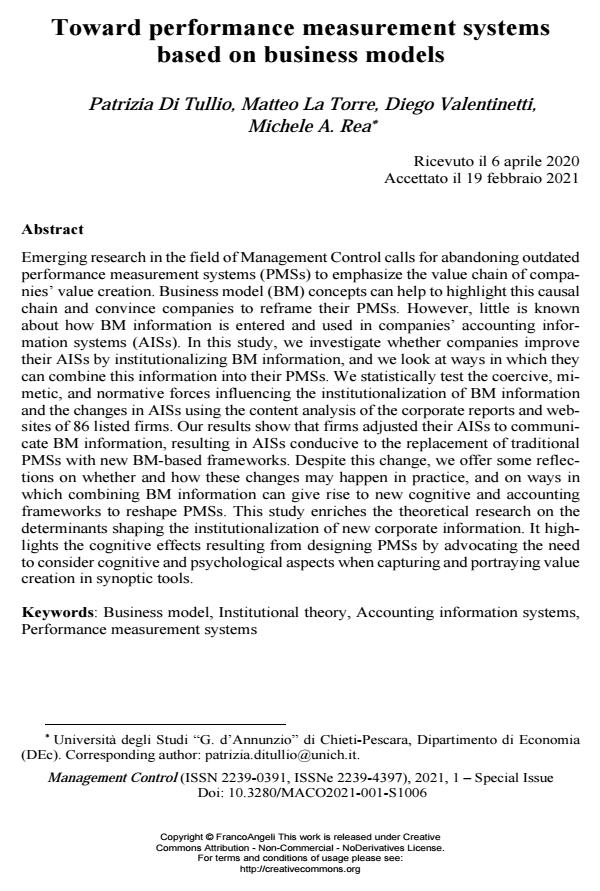Toward performance measurement systems based on business models
Journal title MANAGEMENT CONTROL
Author/s Patrizia Di Tullio, Matteo La Torre, Diego Valentinetti, Michele A. Rea
Publishing Year 2021 Issue 2021/suppl. 1
Language English Pages 26 P. 97-122 File size 4467 KB
DOI 10.3280/MACO2021-001-S1006
DOI is like a bar code for intellectual property: to have more infomation
click here

FrancoAngeli is member of Publishers International Linking Association, Inc (PILA), a not-for-profit association which run the CrossRef service enabling links to and from online scholarly content.
Emerging research in the field of Management Control calls for abandoning out-dated performance measurement systems (PMSs) to emphasize the value chain of companies’ value creation. Business model (BM) concepts can help to highlight this causal chain and convince companies to reframe their PMSs. However, little is known about how BM information is entered and used in companies’ accounting information systems (AISs). In this study, we investigate whether companies im-prove their AISs by institutionalizing BM information, and we look at ways in which they can combine this information into their PMSs. We statistically test the coercive, mimetic, and normative forces influencing the institutionalization of BM information and the changes in AISs using the content analysis of the corporate reports and websites of 86 listed firms. Our results show that firms adjusted their AISs to communicate BM information, resulting in AISs conducive to the re-placement of traditional PMSs with new BM-based frameworks. Despite this change, we offer some reflections on whether and how these changes may happen in practice, and on ways in which combining BM information can give rise to new cognitive and accounting frameworks to reshape PMSs. This study enriches the theoretical research on the determinants shaping the institutionalization of new corporate information. It highlights the cognitive effects resulting from designing PMSs by advocating the need to consider cognitive and psychological aspects when capturing and portraying value creation in synoptic tools.
Keywords: Business model, Institutional theory, Accounting information systems, Performance measurement systems
- Dynamics of Business Models in Industry-Wide Collaborative Networks for Circularity Aleš Krmela, Iveta Šimberová, Viktorija Babiča, in Journal of Open Innovation: Technology, Market, and Complexity 3/2022 pp.3
DOI: 10.3390/joitmc8010003 - SDG reporting and sustainability performance: insights from Italian companies Valentina Beretta, Maria Chiara Demartini, Sara Trucco, in Social Responsibility Journal /2025 pp.1657
DOI: 10.1108/SRJ-07-2024-0492
Patrizia Di Tullio, Matteo La Torre, Diego Valentinetti, Michele A. Rea, Toward performance measurement systems based on business models in "MANAGEMENT CONTROL" suppl. 1/2021, pp 97-122, DOI: 10.3280/MACO2021-001-S1006